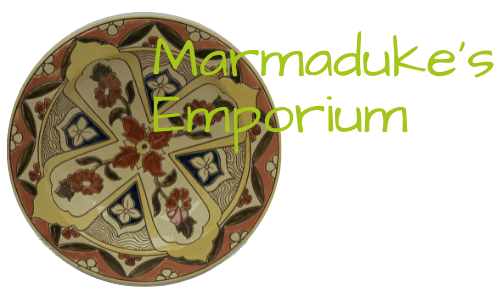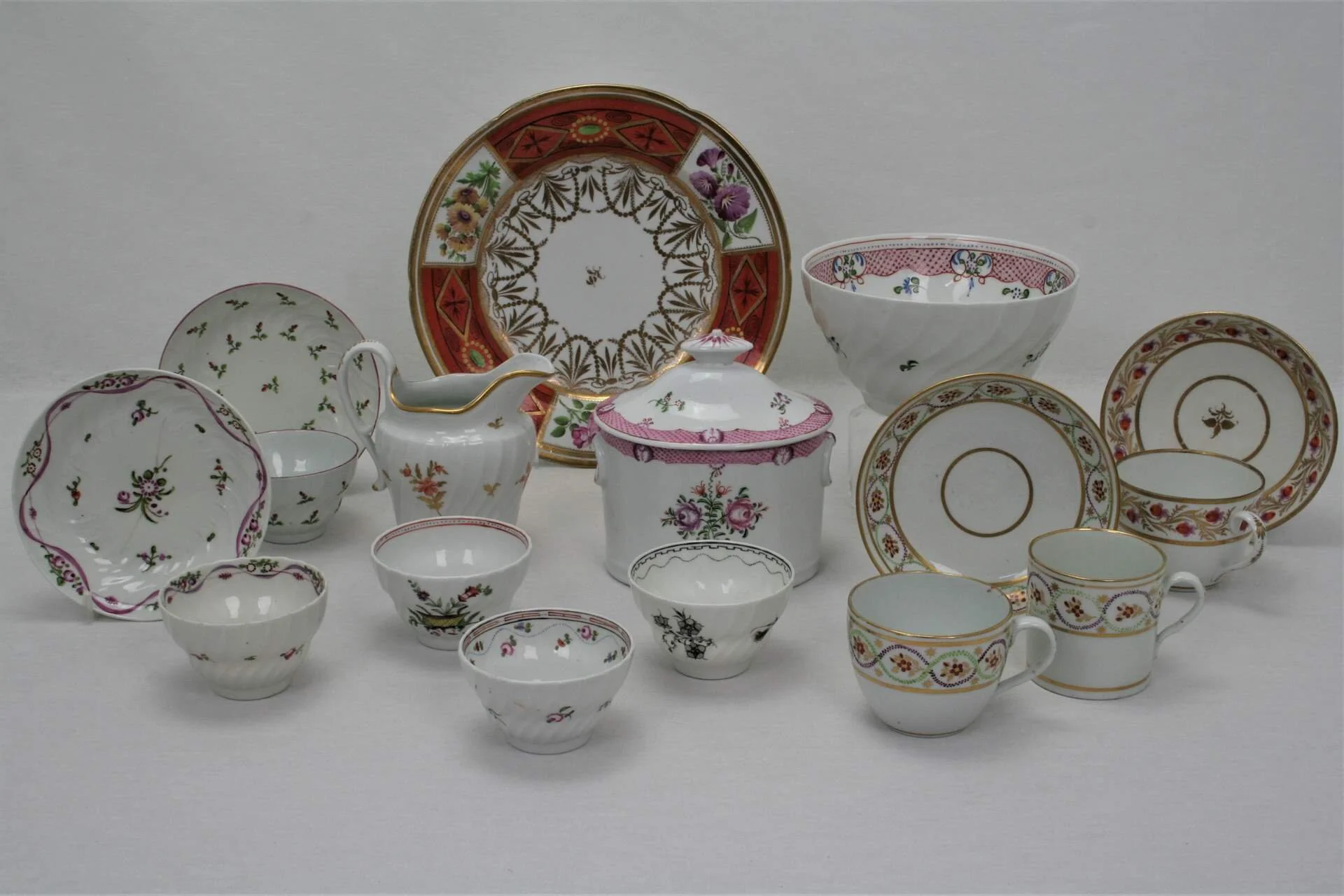
Coalport
It is a little of an exaggeration I know but describing a piece as being made by Coalport is like taking a Minton Vase and saying it was made by Stoke!
John Rose was an apprentice at Caughley but he was a man with ambitions and around 1794 had set up a small porcelain factory in Jackfield which became known as the Calcut China Manufactory. It has only been recently, that through the endeavours of Roger S. Edmundson that a class of wares have been identified as being made at Calcut and damn fine they are too! Large cabbage leaf jugs transfer printed in blue and white together with teawares made with sixteen facets in both transfer printed blue and white patterns and hand painted polychrome decoration.
After his success at Calcut, Rose, who was still only 24 years old, opened his new works at Coalport in 1796 and was soon producing quality tea wares and elegant spiral fluted jugs.
Early John Rose Coalport Transfer Printed in Underglazed Blue and White Patterns
A large jug in the Parrot Pecking Fruit pattern with a spiral fluted moulded section to the main body, dating from 1805 or so.
In 1799, John Rose and his partners, bought the Caughley factory and that included the moulds, copper plates and unfinished stock, so it is not surprising that much of Rose’s early production bears a strong resemblance to Caughley wares but the underglazed blue prints tend to be a little paler on a harder paste body.
In 1800, John Rose’s younger brother Thomas, aged 19, started a porcelain factory on the other side of the canal, in partnership with William Reynolds and William Horton, transforming yet another potworks. William Reynolds was also John Rose’s landlord!
It is understood that as separate companies they were in competition for sales but on a day to day basis the relationship was much more pragmatic and on a Friday afternoon a completed order could well have been a combined effort.
Early Polychrome Coalport Teawares by both John and Thomas Rose some in the New Hall style popular at the time.
The John Rose partnership broke down in 1803 and the company went bankrupt when Edward Blakeway’s banking activities got the better of him and took the Coalport business down too. John Rose wasn’t to be beat and he was up and running under his own steam very quickly.
Both John and Thomas were producing wares of fine quality but Thomas concentrated on tea wares and created a great many more patterns in the Classical and Japan/Imari styles.
Coalport Regency Pattern Teawares in the London Shape
More Elaborate Coalport Regency Teawares in London Shape to the bottom and Bute Shape on the top. Note the Etruscan Style to the centre with the high loop handles, very attractive but as about as practical as drinking tea out of a bucket!
It can be sometimes problematic distinguishing between John Rose and Thomas Rose wares but much was achieved by the researches of Roger S. Edmundson with the help of the Coalport Museum. All the cups and saucers above are unmarked, sometimes pattern numbers were used, mostly on Thomas Rose and if the pattern number is over 1000, it is definitely Thomas Rose. The London shape cups and saucers to the far right in each photograph above are by Thomas Rose.
The Thomas Rose partnership dissolved in 1814, the factory closed and subsequently John Rose took it over.
A superb facetted vase decorated with panels of birds and flowers to both front and back on four moulded feet. The only problem is that it wobbles! Dating from about 1815, it came from local Stately Home clear out back in the 1950’s.
By 1820, the company was still flourishing and acquired the factories of Swansea and Nantgarw, not as going concerns but for the equipment and as a shrewd business move.
A Regency six lobed plate dating from about 1810. The lobes weren’t part of a mould, they were done by hand whilst the body was still wet, sometimes human error crept in and they aren’t very even! The six lobes are a good indicator of the plate being manufactured at Coalport when other attributes are not forthcoming.
Some examples bearing the elaborate Society of Arts award mark to the reverse. The award, made on the 30th May 1820, was for the introduction of a leadless felspathic glaze. There had been considerable concern at the use of lead in the manufacture of ceramics and a number of cases of lead poisoning. With typical Victorian exaggeration, Rose advertised that the award was for the product as a whole and not just the glaze but it did coincide with improvements to the porcelain body making the wares more stable and consistent, though it can be a bit on the heavy side.
“If you think you have something that we would like to add to the collection please contact us!”

Tastes changed in the 1820’s and 30’s and coloured grounds and flower groups came to the fore. New shapes were introduced with elaborate decoration by leading artists such as Joseph Birbeck and Thomas Dixon. As the shapes went out of fashion they were still sold with cheaper, cruder designs. Good business at the time but unhelpful to today’s Coalport officionados.
Typical Coalport Rococo Style Teawares from the 1830’s. The cups on the left are of the “Seven” shape with the open handle and that on the right “Adelaide” shape
Following John Rose’s death in 1841, his nephew William Frederick and a recently appointed partner William Pugh ran the company. They were capable of creating magnificent pieces, with Sevres a clear influence and with painters such as John Randall and William Cook at hand, there is much from the period to be admired. They often worked on the same pieces, Randall’s birds to the one side and Cook’s flowers to the other. Much of the everyday production was fairly simple and utilised printing with overpainting techniques which was relatively cheap to produce. This type of ware is generally not thought to be very attractive today so is often ignored and can be bought quite cheaply.
John Randall decorated plate dating from the 1860’s
Coalport Cabinet Cup and Saucer with the brown Salopian mark from the 1860’s
Coalport Cabinet Cup and Saucer from the 1860’s with the CSN Ampersand mark
When William Pugh died in 1875, the company was in debt and was placed into receivership. In 1876 Thomas Gelson was appointed as Receiver and Manager with the aim of sorting out years of mismanagement but Gelson’s skills were somewhat lacking and he was also responsible for introducing many different shapes and patterns in a late Victorian exuberant style. It was a bit of a case of throwing mud at a wall and see what sticks, unfair probably and not a great analogy for porcelain!
Gelson was also attributed with universally marking the products starting with the two line COALPORT AD 1750 mark. It has always been a source of amusement that the date of establishment of the Coalport factory was claimed to be 1750 on the printed marks. It probably stems from the date of the original potworks that John Rose took on at Calcut or the one Ambrose Gallimore took on at Caughley, both are just a little bit tenuous.
Two Moonflasks dating to the 1870’s with the two line Coalport mark in green. Moonflasks were popular shape, in the aesthetic taste, produced by many of the English factories.
Coalport was taken out of receivership in 1880 by Peter Bruff, a successful civil engineer and entrepreneur from Essex, who was also responsible for founding Clacton on Sea and together with his son Charles, who had returned from India to manage the company in 1889, they returned Coalport to the success it had once been. They had energy, vision and probably a fair dose of luck. They employed talented artists and designers and took on Thomas Bott as their first Art Director. They stopped imitating others and introduced unique and elaborate designs that required skilled gilders and artists such as E. O. Ball, Percy Simpson, J. H. Plant, F. H. Chivers, F. Howard and Thomas Keeling who were allowed to sign their own work. They pursued every avenue, opened up export markets and made such diverse items as superb quality parasol handles to commercial cream pots. They also introduced one of the most iconic Coalport designs commonly known as Bat or Batwing pattern but was known at the factory as Panel pattern. It soon became popular and came in a range of colours and it remains very popular with collectors today. Some collectors don’t collect anything else; only Bat Pattern.
Coalport Churn Shape Cream Pots on the rear left and rear right and a commemorative Cream Jug to the centre. To the front are rare parasol handles.
Superbly decorated Coalport cabinet plates, the examples to the left and right are by Percy Simpson and the centre one is by Arthur Perry.
Loosely described as commemorative wares, produced on commission. A plate and tankard commemorating Captain Matthew Webb, the first man to swim the English Channel to the rear left and front right. Coalport was well known for producing commemorative tankards and loving cups to mark family events such as marriages, christenings and coming of age. Dating to around 1860, the tankard to the front is initialled to the front and has an image of Fletcher’s barn, Madeley. The plate to the right is part of a dessert service produced to commemorate a wedding of an important local family, dating to 1904, with handpainted scenes to the centre of local landmarks.
Charles Bruff sold Coalport in 1924 to Cauldon Potteries Ltd. and production moved to Stoke in 1926 and the Coalport Company is officially dead to me from that point! Well, no not really, they still produced some quality items and designs in Stoke. For example, Percy Simpson, the Art Director by this time, moved to Stoke with the Company and he kept his hand in producing some fine quality painted items, probably right up to his retirement in 1956.
At its best Coalport could compete with any English porcelain factory in terms of quality and in the early days of John Rose in quantity too. The evolution of Coalport China is of endless fascination to me, as much as how their beautiful products that left its doors delight me and the seemingly endless range amazes me!
Some Coalport Birds!
Locally, the best places to see collections of Coalport are, not surprisingly, the Coalport Museum, part of the Ironbridge Gorge Museum Trust and the Shrewsbury Museum and Art Gallery.
The best Coalport mark ever!


















